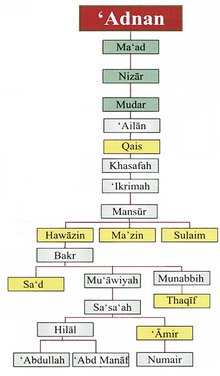Hawazin
| Hawazin ( Arabic: هوازن) | |
|---|---|
| Qaysi | |
 Banner of the Hawazin at the Battle of Siffin | |
| Descended from | Hawazin ibn Mansur ibn Ikrima ibn Khasafa ibn Qays ʿAylān ibn Mudar ibn Nizar ibn Ma'ad ibn Adnan. |
| Parent tribe | Qays |
| Branches |
|
| Religion | Polytheism (Pre-Islam) Islam (Post Islam) |
The Hawazin (
The tribe often clashed with their one-time patrons, the
According to oral tradition and genealogy studies, the modern-day tribe of Otaibah based in Saudi Arabia are descendants of the Hawazin.[1][2][3]

Origins and branches
The tribe formed part of the larger
History
Pre-Islamic era
The Hawazin were pastoral nomads that inhabited the steppes between Mecca and Medina.[5] Beginning around 550 CE, the Hawazin became a vassal tribe of the Banu 'Abs of Ghatafan under the 'Absi chieftain Zuhayr ibn Jadhima.[6] [7] When the latter was killed by the Banu 'Amir ibn Sa'sa' some years later, the Hawazin discontinued their tribute to Ghatafan.[6][7] Sporadic battles and wars occurred in the following years, often between the bulk of the Hawazin, in alliance with the Banu Sulaym, on one side, and the bulk of the Ghatafan on the other.[6] Less often, there were armed feuds among certain Hawazin subtribes, particularly between the Banu Jusham and Banu Fazara.[6]
During the
After hearing news of 'Urwa's death, the Hawazin pursued al-Barrad's Qurayshi patron
Islamic era
There was scant contact between the Hawazin and the
The Hawazin discontinued the sadaqa (voluntary donation) given to Muslim authorities in Medina following Muhammad's death in 632, and like many other Arab tribes, Hawazin did take part in combat against the successor of Muhammed, Abu Bakr during the Ridda Wars. Hawazin ultimately returned to the Islamic fold by the end of the war.[11][12]
References
- ^ Al-Qthami, Hmood Dawi (1985). North of Hejaz. Jeddah: Dar Al Bayan.
- ^ Al Rougi, Hindees. "The Tribe of Otaibah". Archived from the original on 2018-05-14. Retrieved 2017-11-19.
- ^ H. Kindermann-[C.E. Bosworth]. "'Utayba." Encyclopaedia of Islam. Edited by: P. Bearman, Th. Bianquis, C.E. Bosworth, E. van Donzel and W.P. Heinrichs. Brill, 2007.
- ^ a b c d e f g h i Watt 1971, p. 286.
- ^ Donner 2010, p. 95.
- ^ a b c d e Watt 1971, p. 286.
- ^ a b Fück 1965, p. 1023.
- ^ a b c d e f g Fück 1965, p. 883.
- ^ Ibn al-Atheer Abu Hassan. asid alghabat t aleilmia (in Arabic).
- ^ almaseudiu. altanbih walashraf (in Arabic).
- ^ Donner 2010, p. 101.
- ISBN 978-1-900724-47-0.
Bibliography
- Donner, Fred M. (2010). Muhammad and the Believers, at the Origins of Islam. Cambridge: The Belknap Press of Harvard University Press. ISBN 978-0-674-05097-6.
- Fück, J. W. (1965). "Fidjār". In Lewis, B; Pellat, Ch; Schacht, J. (eds.). The Encyclopedia of Islam, Vol. 2, C-G (2nd ed.). Leiden: Brill. pp. 883–884. ISBN 90-04-07026-5.
- Fück, J. W. (1965). "Ghatafan". In Lewis, B; Pellat, Ch; Schacht, J. (eds.). The Encyclopedia of Islam, Vol. 2, C-G (2nd ed.). Leiden: Brill. pp. 1023–1024. ISBN 90-04-07026-5.
- Watt, W. Montgomery (1971). "Hawāzin". In Lewis, B; Ménage, M. L.; Pellat, Ch; Schacht, J. (eds.). The Encyclopedia of Islam, Vol. 3, H-Iram (2nd ed.). Leiden: Brill. pp. 285–286. ISBN 90-04-08118-6.
